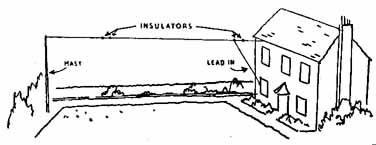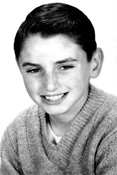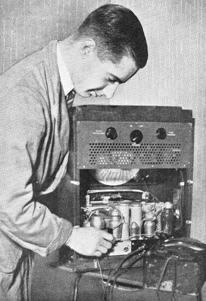
Early days

My interest in all things radio started in my childhood with the coming of the "repair man". This hapless individual would have been summoned by my parents to investigate the "sound's gone funny" or whatever other technical description was offered. From the moment he took the back off the set he would have an irremovable shadow, peering over his shoulder. I was that shadow! The dark and dusty interior of the "wireless" held a total fascination for me. What were those big cans? Why did you twiddle that screw? Poor man. He would be continually pestered with questions and be required to explain his every action. He must have been very glad to get out of the front door!

I still have a wonderful old book called "The Handyman and Home Mechanic" that I used to spend hours leafing through. Sandwiched somewhere between "Installing electric light" and "Overhauling the modern gas engine" was my favourite chapter, "Wireless". This contained much advice about installing an outdoor aerial and the charging of accumulators and my favourite picture "The fascinating mechanism of radio"!
Then came the television. This was even more exciting. I think the view inside the back was more compelling than what was on the screen (watching a black and white image of a teleprinter bobbing out the football results on Saturday afternoons didn't really arouse my interest!). I remember one service engineer who painstakingly re-laced a focus coil using black twine ("Don't think much of this new-fangled plastic tape, sonny!"). That’s dedication for you!
The next discovery was short waves. I'd noticed that some radios had an extra position on the wave-change switch that the owners never seemed to use. Everybody listened to the "Light Programme" on Long Wave. Some would tune the Medium Wave for the "Home Service", the Third Programme" (very posh) or "Radio Luxembourg" if you were really adventurous. But the Short Wave position was always pristine due to lack of use. It corresponded to dial markings with seriously far-away names. Places like Moscow, Tirana, U.S.A. and the mysterious "Amateur" (more of that later).
Eventually I acquired a set with that magic short wave band on the dial and opened up a whole new world of listening excitement. Not only were there all these exotic stations, some of which broadcast in heavily accented English, but there was a whole gamut of weird noises in between. I later discovered that these were things like teleprinters and jammers but at the time they were just brilliant sound effects and they must have driven my poor parents mad!
The next thing was aerials! All the books said reception would be much improved if you had lots of wire in the sky. But where to get the wire? My solution was to cannibalise old transformers stripped out of defunct radios (i.e. those without short waves!). The problem was of course that the wire was inevitably around 40swg (i.e. not much thicker than a human hair!).

So aerials went up - strung around trees, washing poles, next doors chimneys, etc. (nothing like the pictures in the book!). In fact anything I could throw a suitable projectile over (scrumped apples worked well). And of course down they came again in the slightest wind! But I didn't care - all sorts of new transmissions were coming in. And some of them weren't just commercial broadcasters. These were the days when Radio Amateurs used good old a.m. (ancient modulation!) which could be received on a domestic receiver. I was starting to hear tantalising snatches of call-signs repeated over and over using Z-cars style phonetics. This was soon to lead to a whole new area of interest…
To be continued - visit again soon!
Back to Old Radios Page